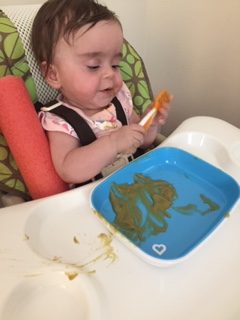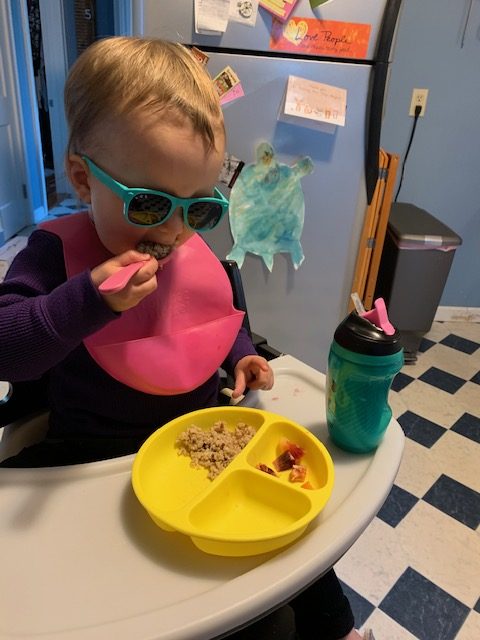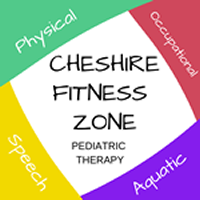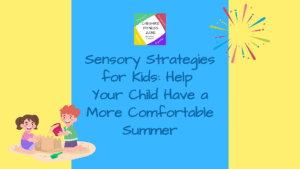Helping children of all abilities develop the skills to eat and drink safely and peacefully.
Our feeding team, comprised of Speech Language Pathologists and Occupational Therapists, apply principles from advanced training to evaluate and treat patients with feeding concerns. We work with children who experience difficulty with acceptance of new foods/textures, patients who have feeding disorders, known as dysphagia, as well as babies who experience difficulty with breast or bottle feeding.
Continue reading for positive changes all parents can make to help your child have a good feeding experience!
Positioning in a Chair
Stability in a chair allows your child to focus on eating instead of working to maintain balance
- Babies: Once a child is sitting up and knees bend over the seat of the highchair, it is important to support the feet (you can use your knees as a place for your child’s feet). Your baby should be sitting upright, not too far forward, or leaning to either side (use a folded towel to support your child). The tray should be at the bottom of your child’s breast bone and they should be resting their arms and elbows on the tray.
- Toddlers and preschoolers: Your child’s feet should not be dangling from the chair but be grounded on the floor, stool, or footrest on the highchair with knees comfortably bent. The tray or table should be at chest level with elbows comfortably resting on the table so finding a chair that is the appropriate height to match the table is important!
- The caregiver’s position is important, too! Sitting at eye level improves your child’s head and tongue position making it easier to receive the food from the utensil without throwing the head back or thrusting the tongue forward.

Feeding Cues
Your child will give clear cues when done feeding. Respecting those cues is important. Most healthy babies have the ability to self-regulate when and how much they need to eat. They have internal sensations of hunger and satisfaction. It’s imporant to remember that your child may eat like a truck driver one day and a bird the next. Respecting your child’s appetite is important!
Babies:
- Your baby will stop sucking, push the nipple out of the mouth with the tongue, turn head away, arch back, push the bottle away, or clamp his/her mouth shut.
- Common ways caregivers ignore or override cues: holding the baby’s head or arm movements, preventing the child from giving signals of satiety; applying pressure to cheeks to make baby suck more (unless therapist recommended as therapeutic strategy); jiggling or twisting bottle in baby’s mouth; squeezing milk in baby’s mouth; trickery like alternating pacifier and bottle nipple; or repeatedly placing the nipple in baby’s mouth despite the cues indicating satiety.
Toddlers and preschoolers:
- Sometimes it takes many, many tries of a new food before your child decides to like it! Don’t give up but don’t pressure your child either. Respect your child’s “no” but DO continue to offer and expose your child to the new food frequently for future meals. Your child may surprise you and give it a try!
- Offering new foods with different colors, tastes and textures is important. Variety is key!
A Note on Parent Cues: A relaxed feeding environment with the expectation that feeding is enjoyable will help your child develop a good relationship with food. It’s important not to label your child as being “picky” or declare that your child doesn’t like a particular food. Simply present the food and model eating that food in a positive manner.
Teaching Acceptance of Different Textured Foods
- Getting messy and exploring food is imporant. Decreasing sensitivities to tastes and textures start with the hands. Allow your baby and toddler to play with their food. Getting messy is important!
- Do allow your child to mouth a variety of safe baby toys/teethers/chewing tools with different textures. Mouthing is necessary to decrease sensitivities in the mouth and shift your child’s gag reflex further back on the tongue.
- Some gag is perfectly normal when your child is trying a new food! Gagging and tongue thrusting when baby is first introduced to solids is normal. Chewy tubes and other mouthing toys can help some children decrease their gagging.
- Purees should be the quick bridge you cross to get to soft textured solids. Staying with purees too long may prevent your child from transitioning to solid foods with more texture (baby food pouches are purees!) Babies are ready for solids usually between 6-8 months. Talk to your pediatrician if you are unsure when or what to introduce and what NOT to introduce.
-

Getting Messy Using a Dipper Spoon! -

Short, fat handled spoons are best for when the child is learning to hold a spoon and self feed. As the child matures and learns to use a mature grip (pictured here), the handle can be longer.
Utensil Fun (spoons, cups and bowls, Oh My!)
- Handles: Long handled spoons are for parents when feeding their child and short fat handled spoons are for the child to hold when they are learning to self-feed.
- Bowl of spoon: Dipper spoons can be used with babies as young as 6 months to teach them to dip a utensil in their food and bring their hand and arm towards their mouth. Developmentally, dipping occurs first. After this is mastered, toddlers can be given a shallow bowled spoon to encourage scooping the food from the bowl. They are learning to rotate the wrist towards the mouth when using a utensil. Your child may still be eating with their fingers but as they become more confident with practice, the spoon often becomes their first utensil. Your child’s skill with the spoon will improve with exposure and practice.
- Fork self-feeding usually (not always) comes after the spoon. The fork should be designed for a child and fit the child’s mouth. Like the spoon, the handle should be short with tines that are slightly rounded. Ice cube trays and partition plates help kids become successful with stabbing the food as they offer a barrier and prevent the food from moving away from the fork. Like the spoon, your child’s skill using a fork will improve with exposure and practice.
- Open cup drinking is important! It promotes lip closure and strength and helps your child grade the movement of the jaw (not too open or not too closed). Cut out cups that have one side of the rim lower than the other side, are a great option for teaching open cup drinking. They allow the caregiver to control the amount of liquid they are pouring into the child’s mouth and the child’s small hands can also fit nicely around the cup so they can help pour the liquid into their mouth. Handles on the cup also make holding a cup easier.
- Straw drinking is important, too! It teaches your child to use a mature swallow pattern. This is when the tongue tip lifts up to the alveolar ridge (the bony ridge behind the two top front teeth) and with a wave-like movement moves the liquid or food back to be swallowed. This is a very different tongue movement pattern than the one your baby uses for the bottle or breast.
Our Approach When a Child Has a Feeding Aversion
- The child learns to explore a variety of food using all of his/her senses at his or her own pace. We talk about the textures, the colors, and the smells of food. We often cook and prepare food together.
- We strengthen the child’s oral motor skills when needed and we focus on those functional skills that will improve feeding (improve lip closure for spoon feeding).
- We modify the utensils the child uses when needed, helping parents find the best cup, bottle or nipple to make feeding or drinking easier for the child.
- We always make sure the child is sitting properly. Posture in the high chair or at the table is very important!
- We help parents understand their role in the feeding process.
- We make sure parents feel they are part of the team, teaching them strategies to become successful at home.
At Cheshire Fitness Zone Pediatric Therapy we see many children who have feeding aversions. We fully assess the child’s sensory and motor skills and work as a team to find the best approach to help the child develop a good relationship with food. Parents are very much part of the team. We never force a child to eat a new food or trick a child into eating new foods.
We are a diverse team of occupational therapists and speech and language therapists with advanced training in various feeding approaches. We also have a supportive team of physical therapists to guide the feeding team with proper body alignment and posture.
If you are interested in scheduling your child a feeding evaulation please fill out our simple online form.







